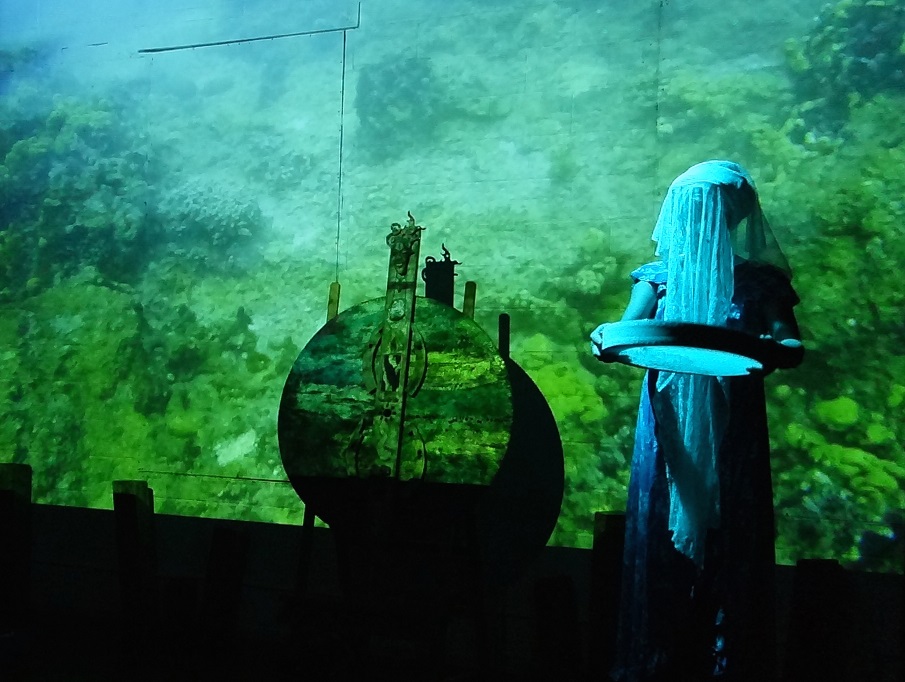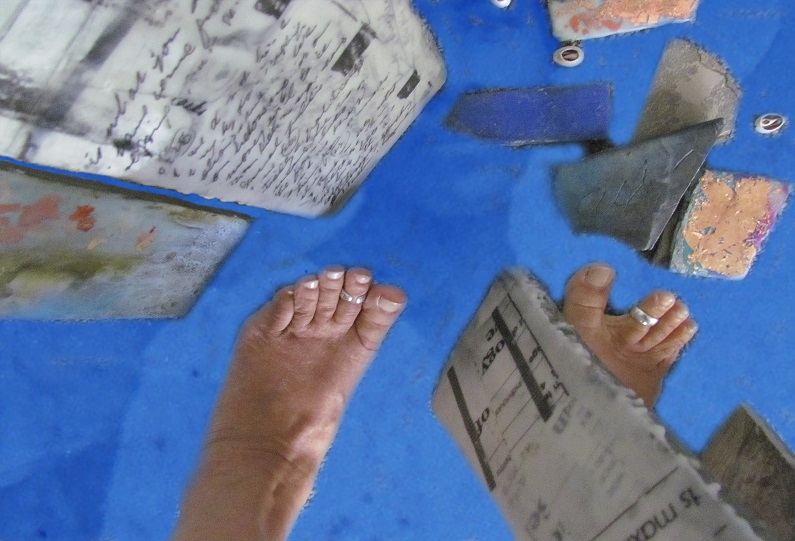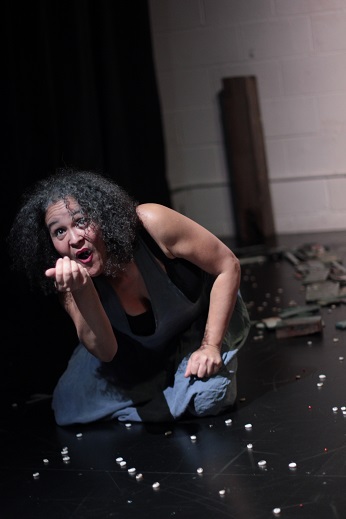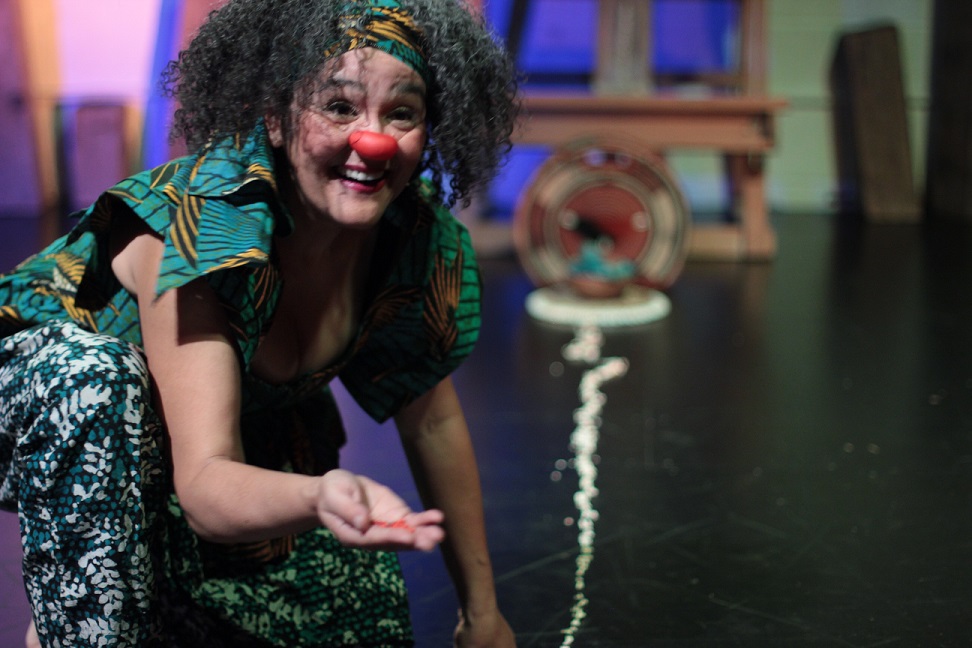By Jane Litchfield
In J’ai Soif, Mosa McNeilly is a clown. She has a round red nose, in the European tradition. And African attire. And brown skin. And this clown finds herself on a slave ship. If some of this makes the audience uncomfortable, that’s okay. It’s meant to.
Clown Searching, 2015. Mosa McNeilly in performance, in Sipping Freedom & J’ai Soif, Aluna Theatre, Nov. 20, 2015. Photo by Anique J. Jordan.
The clown is one of nine characters McNeilly plays in her performance art installation Sipping Freedom & J’ai Soif*. And “performer” is just one of many hats this Guelph artist wears.
McNeilly is also a visual artist, vocalist, spiritual practitioner, researcher, educator, and editor. She has a background in dance, storytelling, and spoken word. And she has just completed her master’s degree in – wait for it – Environmental Studies.
That degree makes perfect sense if you think the environment includes cultural life, as McNeilly does. She suggests the environment includes the spaces in which humans live, work, worship and play. It’s all a part of “embodying the sacred,” one of the themes in her work. “What’s missing in the notion of ‘the human’ in Western contemporary thought is our relationship to the sacred. African and Indigenous cosmologies teach us that we access the sacred through communing with the natural world.”
McNeilly makes a habit of shining a light on the way we think in contemporary Western culture. “It is important for me to make visible what is erased and buried.” For instance, she calls Black History Month “African History Month” to make Black people’s origins more visible.

Born and raised in Toronto, McNeilly has been living in Guelph with her daughter for 10 years. McNeilly says that although Guelph has a vibrant arts scene, she feels isolated as a Black woman artist addressing issues of race in her work. “I’m imagining a world where Afrodiasporic knowledges are valorized as contributing to human evolution. And I enlarge the definition of Blackness to include Indigeneity and Mixedness.”
McNeilly also works to break the bounds of chronology. She draws on “Black radical imagination”, a way of thinking in which the present does not have to determine the future, drawing on the tradition of radical imagining that characterizes Black diasporic life.

Mínkísí’s Crossing, 2015. Mosa McNeilly in performance with video, Path of Bones, in Sipping Freedom & J’ai Soif, Aluna Theatre, Nov. 20, 2015. Photo by Anique J. Jordan.
Another area that McNeilly is “just starting to sink [her] teeth into” is “orature,” a word coined by Ugandan scholar Pio Zirimu to avoid the oxymoron “oral literature.” McNeilly, who enjoys playing with words, likes the idea that orature counters literature as the main way we transfer knowledge.
Orature can involve sharing knowledge through rhythm, movement, voice, storytelling, or spoken word, giving each equal value. Fittingly, in Sipping Freedom, only one of the nine characters speaks; everything else is movement-based.
McNeilly calls herself a “transdisciplinary” artist, rather than multidisciplinary. The set for Sipping Freedom includes more than 200 pieces of slate treated with the encaustic techniques of painting, photo-transfer, layering, gouging, and sgraffito to convey the concepts of fragmentation, indecipherability, violence and erasure. The production is grounded in “Middle Passage Memory”, remembering the journeys of thousands of slave ships across the Atlantic, and memorializing the millions of lives lost on the way. The stones represent a path of bones on the ocean floor.

Path of Bones 15, 2015. Mosa McNeilly, digital photo collage.
McNeilly would love to continue to develop Sipping Freedom, which she has only presented as a workshop production in her master’s degree so far. “My dream life would be to be totally immersed in fully funded art and performance studio practice: To develop this production with a full production team.”
In the meantime, the other hat McNeilly would like to wear is her editor’s cap, as she looks to find a niche as a freelance editor for Black and Indigenous scholars, artists and social justice organizations.
And she will continue to tell Black stories in her transdisciplinary way. Although McNeilly’s work contains narratives of outrage and grief, it is also deeply hopeful. “We must be hopeful. It is hope that propels us to imagine futures of possibility,” she says.
“The present is the history of the future. If we jostle things now, the future may stand a chance to be different from the present.”

_____________________
*The title J’AI SOIF is sourced from Zong! by NourbeSe Philip. M. NourbeSe Philip, Zong! (Middletown: Wesleyan University Press, 2008








